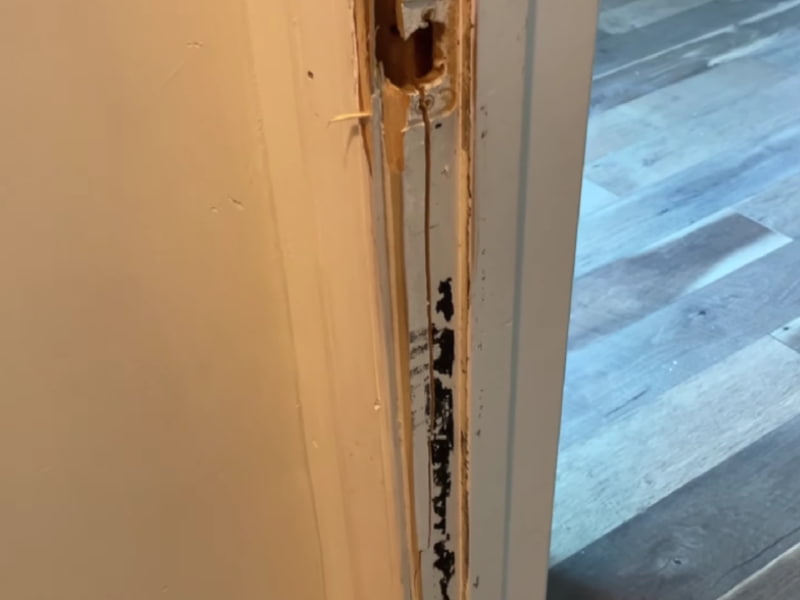How to Fix a Kicked in Door Frame (Door Jamb Repair Guide)
A door jamb is a vital part of your door that’s often mistaken for a door frame. A door jamb refers to the two vertical pillars that stand parallel to your door. You install hinges and hangs on a door jamb, so when it is kicked in, the door won’t function. So, how do you repair a kicked-in door frame and jamb?
You can make a door jamb using wood, metal, and various other materials. Commercial houses often have wooden doorposts for interior doors, while others might include hollow metal or fiberglass.
It is crucial to quickly repair a damaged door jamb to improve one’s security within their home. You might also need to conduct regular inspections and identify potential areas of weakness before they deteriorate and compromise the safety of others within your home.
Can you replace part of a door jamb?
You can replace some parts of a door jamb by sanding and applying wood filler, but this fix works only for minor damages. If the jamb and frame are extensively damaged, you may need to install a new door jamb.
Door jambs are generally durable and should last for decades. You’ll need to replace the jamb if it was broken and the case damaged.

Contrary to popular opinion, door jambs are sophisticated pieces of hardware that consist of several other parts in addition to hangs and hinges.
The head/top jamb is the topmost part of your door. You can notice it as the horizontal wooden/metallic beam that supports both sides of the door. The Side jambs (often mistaken for a door frame/jamb) provide stability and help reinforce other parts of your door.
Good workability is essential when working on a door jamb, especially when installing hinges and other appliances. You are more likely to find others made using softwood, hollow metal, or plastic than hardwood and metal due to their costs and difficulty working with such products.
Most doors have a trim casing between the wall plaster and the frame. Experts insist on leaving a small space between your door frame and the rest of the wall. The covering is crucial because it helps conceal gaps, holds part of your door jamb, and improves the overall aesthetic effect of your living space.
Doors are often damaged by weather, during break-ins, and repairs.
Whenever a part of your door becomes damaged, the casing provides an efficient means of fixing the affected section without necessarily having to remove the entire frame.
How to Fix a Kicked-in Door Frame (jamb)
Doors have robust and sturdy characteristics which complement their security function. Most door slabs are difficult to break using brute force, but if one happens to kick in a door at an exposed weak point, the frame can break easily and leave you in a vulnerable position.
The extent of the damage will determine whether you can fix it yourself or hire the services of a technician. It’s always a good idea to hire an expert from a reputable institution for quality service and feedback whenever something goes wrong. Most technicians charge between $30-80 per hour depending on the region and type of door that requires repair.
But if you prefer working on the frame yourself, always ensure you know how your door functions, the necessary tools, and the scope of damage before you begin working on your door jamb.
If the damage is severe, you might have to remove the entire frame of your door and work on its installation afresh (you might also have to buy a few parts). However, if your door has only suffered moderate damage, you can remove the affected section taking care not to compromise the integrity of the rest of the frame.
Here’s how to fix a kicked-in door frame:
1. Measure the area occupied by the door frame
You can use a tape measure to take accurate recordings of the width of your door frame and the thickness of the different segments. Having precise measurements gives you an idea of the building and might be beneficial in correcting possible future errors during reinstallation. You can also draw a small sketch on a piece of paper to create a simplified scale-sized image.
2. Remove the door slab
The next step involves removing the door slab (the part of the door that swings). You might need a small hammer and a screwdriver. You can start by lightly tapping on the hinges close to the screws to loosen them before using a screwdriver to separate the slab from the rest of the frame.
Be sure to pay special attention to the direction of the door handle, as it can help you determine which side is ideal for opening or closing the door.
3. Look for the wall casing and remove the molding
The molding is likely near the outer edge of the frame, usually covered by trim. You can use a small utility knife to cut off the trim mold away from the rest of the door. The process might become messy, so it’s always a good idea to wear eye goggles and other protective attire while working.
4. Pry the damaged jamb off the wall
Use a set of pry knives to remove the damaged piece from the wall. Use regulated amounts of downward pressure to separate the frame while taking care not to damage the rest of the wall in the process. You can also use small shims to complement your effort before cutting off the damaged section using a handsaw.
5. Replace the damaged jamb with a new one
Make sure to remove any nails from your frame before attempting to install a new doorjamb on your door frame. You should make sure the jamb has a tight fit so that you don’t have to use shims to level out your door after installation.
6. Reinstall the rest of the door and test
Place the door slab in its correct position and use tacks to hold it in place. You can also use a preinstalled door (which comes in standard sizes) and are much easier to use. After ensuring everything is ready, use the correct screws/nails to keep the door upright, after which you need to conduct tests to identify potential errors.
7. Cover the casing with a quality trim
After you are satisfied, the next step includes using an ideal molding to cover the gaps between your frame and wall. Different doors have specific trims specifications ideal for their application. It’s best to conduct additional research on the best trim options for your entrance before settling on a purchase.
How do you fix a broken door frame latch?
Door latches provide extra security and privacy by keeping the door closed until you pull the handle and the latch detaches.
There are several types of latches available in the market. Some of the more popular varieties include the square corner latch, rounded corner latch, and drive-in latch. Different types vary in features, but their core purpose remains the same.
Hardware products, such as latches, are susceptible to several problems such as breaking, latching inconsistencies, poorly configured strike plates, etc.
Most of these problems are simple to resolve and rarely require technical expertise. It is important to remember that each concern requires a tailored approach, which might be unique depending on the latch type and model.
Here’s how to fix a broken door frame latch.
1. Remove the latch
Use a screwdriver to pry the latch off the door. It’s a good idea to have a secure container where you can place your screws and other small pieces that are easily misplaced. Door latches have delicate bits that require attention to detail and smooth handling if they are to work effectively.
2. Replace the affected part
After disassembling all the components, you can now replace the broken part. Sometimes, you might have to replace the entire latch unless the damage is not too severe.
Make sure the replacement fits correctly into the other parts before attempting to reinstall your latch.
3. Reinstall your latch and test to check if it works correctly
Reinstalling your latch should not be too much of an issue, especially if you are confident of your replacement choice.
Bolts and strike patches might take more attention to replace compared to handles and other exterior equipment, but the process shouldn’t be too complicated either.
In case you run into problems, test the latch against the door frame so that you can identify trouble spots and devise a way to fix them. It’s also a good idea to get expert help once a problem becomes too challenging.
What’s the cost to fix a kicked-in door?
Doors differ in terms of features and raw materials. Such considerations make it hard to quantify the overall cost of fixing a damaged door. Besides labor and damage extent, it is crucial to factor in variable prices when quoting a specific price.
A standard wooden door costs around $75-200 for repairs. The cost of replacing it (or parts of it) may be even higher. You also have to consider whether the door is for interior or exterior use, with exterior doors costing slightly more.
The best way to determine the cost of fixing a damaged door is to talk to a technician who can advise you on the best rates, highest quality, and other specified needs ideal for you.
How to secure a door from being kicked in
You can adopt several ideas to secure your door from damage. A primary initiative involves using quality materials during the making of your door. Ensure you use standard wood types and thickness to increase strength and durability.
Another idea involves using strike plate locks instead of door chains. Strike plate locks are more robust and can withstand higher pressure levels than other kinds. Besides, it’s also a good idea to reinforce your door frame and ensure that your door has a sturdy core to protect against forced entry.
- How Do You Stop Water from Coming in Under Door
- Bifold Door Sizes: Chart
- How to Fix Gap Between Door and Floor
- How to Jam a Door and Keep it Closed
- Door Knob Height (+ ADA Handle Dimensions)
